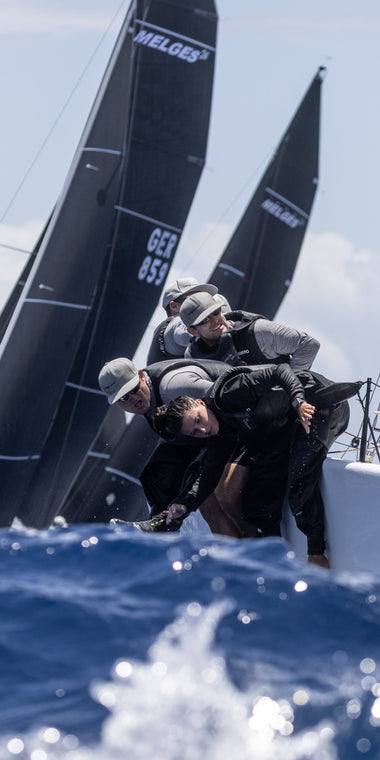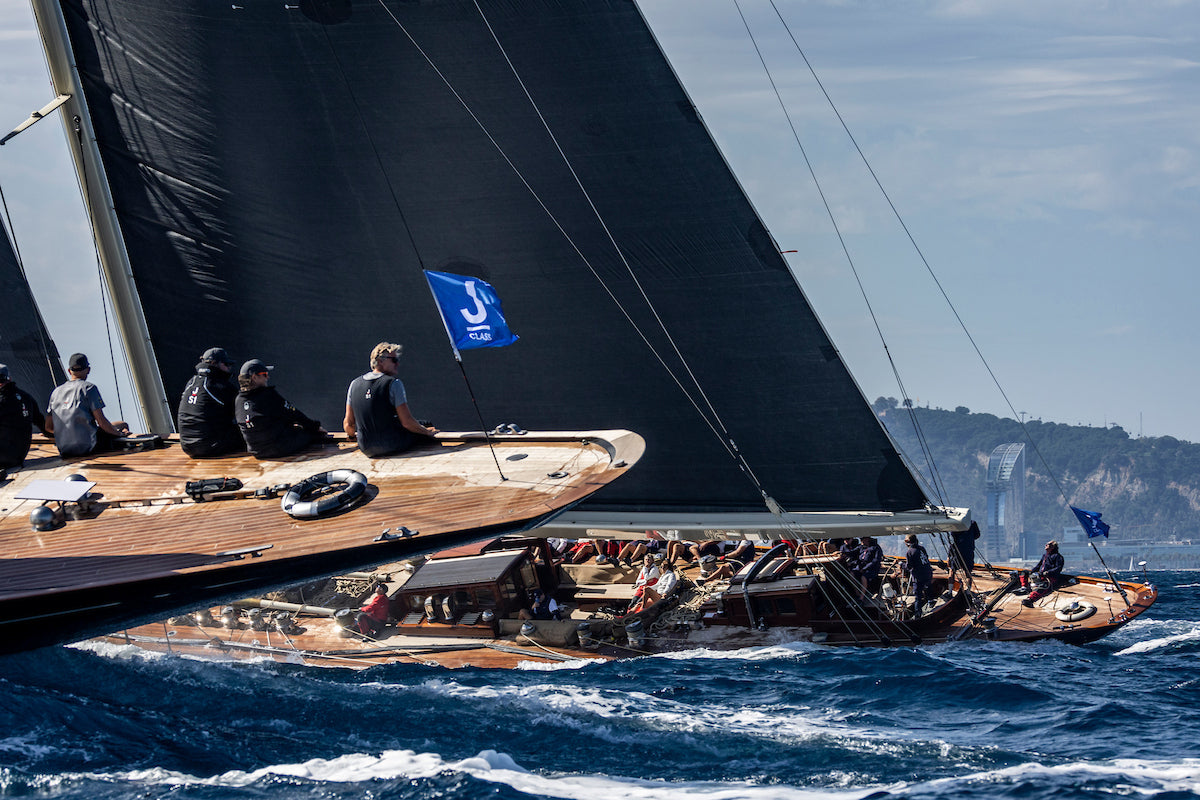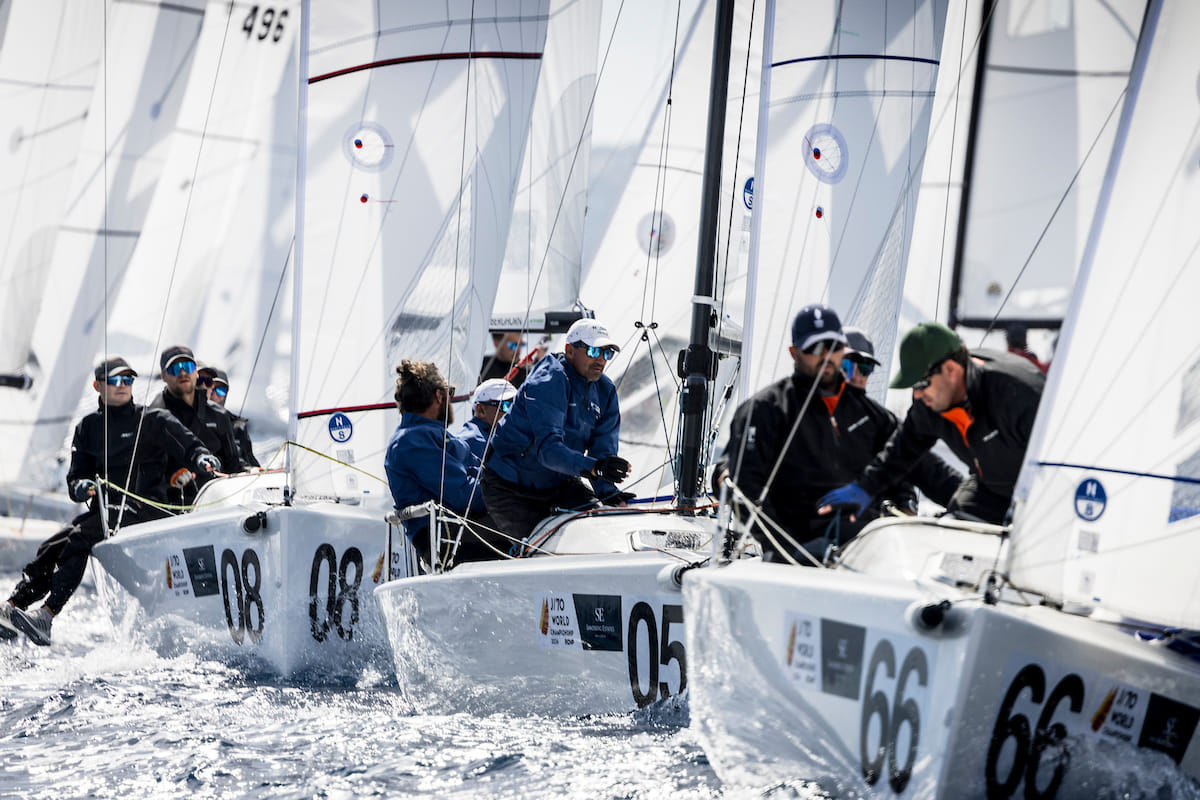SAILORS GEAR UP FOR THE TRANSAT JACQUES VABRE
SAILORS GEAR UP FOR THE TRANSAT JACQUES VABRE
Charles Caudrelier, Charlie Enright, and Sam Goodchild Discuss What It Takes To Campaign For The TJV
Every other year, in late Autumn, there’s a race so exciting that it captures the hearts of the offshore sailing world: the Transat Jacques Vabre. The doublehanded sailing event brings together some of the world’s best (and fiercest) offshore competition on par with the likes of the Vendee Globe and Ocean Race. Interestingly enough, the Transat Jacques Vabre (TJV) features many familiar faces—from 2019 TJV winner Charles Caudrelier to two-time Ocean Race skipper Charlie Enright. The race also attracts many offshore fan favorites like four-time race veteran Sam Goodchild.



The TJV is unique because, unlike the Vendee Globe and Ocean Race, four offshore classes—using cutting-edge design and technology—go head-to-head from Europe to the Caribbean. Many sailors, like Caudrelier, are more than experienced in this offshore stretch of ocean, however, for the first time in the race’s 28 year history, the teams will sail to Martinique in the French West Indies from Le Havre, France. The 2021 race track features three different routes across the four classes to allow for maximum competition.






The TJV is one of many offshore races in a team’s “big picture” calendar however, it is vitally important for a campaign because it allows for essential development and testing in an intense offshore setting. With start set for Sunday 7 November, we caught up with Charles, Charlie, and Sam to discuss how their respective teams are using the TJV as a critical training moment for their three, very different, campaigns. For all three offshore sailors (and their teams), the 2021 TJV will be a testing ground unlike any other. The competitors will be testing themselves, their boats, and their sails.
Charles Caudrelier, Co-Skipper of the Ultim, Maxi Edmond de Rothschild
For Gitana Team onboard their 32m trimaran, this will be an offshore battle of fresh out of the shed boats and the sea-tested Ultims, with Maxi Edmond de Rothschild falling into the later category. “The team has done a good job
In the past, the race has been about seven or eight days long, which when you’re looking for your competitive edge, can often not be long enough. Caudrelier knows these water’s well, “I’ve been sailing in every direction. I’ve done a similar leg three times with the Volvo Ocean Race, so I know what’s going to happen and what the focus will look like, but we’ll have more lessons with the longer race of 12 to 14 days. It will be very interesting in terms of strategies.”
When discussing design and the future of the Ultims, specifically their sails, Caudrelier explained that although it is difficult, the key to a successful race can often come down to the sails themselves.
“We’re not an America’s Cup project where we can try many, many sails or do two-boat testing. So, this is an important race to test our sails because we’re always looking to improve. In a race like the TJV race, the sails really can make the difference.”
“It’s very difficult to design




All five Ultims will be racing with full North 3Di inventories, so, in Caudrelier’s mind, the relationship the teams have with their North Sail designer is essential.
“We work in very close collaboration with our designers for two reasons. Designing, for one, and then ongoing R&D for the future. This is the future, and the sails are the power—the engine of the boat. I’m sure we can improve a lot in this area.”
“With all Ultims on the starting line having North sails, the big choice we can make is the type of sail but also the relationship we have with North Sails and the designer who is in charge of the boat. If you have a good collaboration with your designer, you can always be one step ahead of the other teams.”
Charlie Enright, Co-Skipper 11th Hour Racing Team IMOCA, Mālama
Not yet forty, Charlie Enright is a well-known name in the world of offshore sailing. Having completed two Volvo Ocean Races, a handful of ‘smaller’ offshore races, and one Transat Jacques Vabre, the American co-skipper of 11th Hour Racing Team (Mālama) is ready to take on his second Transat Jacques Vabre.
“The TJV is an exceptionally important race for our team. It is the culmination of all this year’s hard work. It’s also the first real race for us on our new boat.” Enright’s teammates, Justine Mettraux and Simon Fisher will be sailing on 11th Hour Racing Team’s Alaka’i.
“The last time we did this race
There has been a lot of offshore activity this year, but very few with ocean crossings for Enright lasting more than a week. And barely any away from the challenges of land.
“We learned a fair bit during The Ocean Race Europe and the Fastnet, but the TJV is different—for starters, it’s a much longer race at almost 6,000 miles. This means, the boats really get a chance to stretch their legs versus ducking and diving around headlands and sailing close to land. It will be really nice to get all the boats in the same weather system and see what kind of speeds they can reach relative to each other.”
“The TJV helps better understand our sails because we’re going to be sailing on specific inventory combinations for extended periods of time, which is something you don’t really get a chance to do in training. In training, you’re trying to cram as much as you can into a short period of time. Hopefully, the advancements will continue with crossovers and geometries and the results will inform the development of our future sails.”
“It’s important that we have the most reliable sails available to us. We put them through some treacherous conditions, and we don’t want to have to think about babying them as we compete.”



Similar to the Ultim, the IMOCA 60 sails are essential to the engine (and success) of the boat. This means, for Enright and the 11th Hour Racing Team, it’s meant working closely with the North Sails designers. Gone are the days of the sails being almost an afterthought of the boat itself.
“Sails have been a big part of our learning experience particularly with the design of our new boat. The sail designers worked in collaboration with our Naval architects here in France, and all over the world, actually, to develop an overall concept of the boat. The aero package is instrumental to the design of the entire boat—the foils, the hull shape, the systems, everything you can imagine; it’s all intertwined.”
“One great thing about working with North Sails is that we’ve been able to work with various designers with the North Sails global network. Each member of our team feels comfortable working with them not only in philosophy but also with design and technical support. It’s been really great to integrate many members of the wider North Sails team into our project. We’re a French-Anglo team and it’s nice to have designers from both cultures embedded in our campaign.
“We have a lot of experience with the 3Di product from two previous Volvo Ocean Races. To work on custom sails for the IMOCA has been a step up, with the decrease in weight, custom tape layouts, and structures, we’re looking to optimize but we’re always confident with the reliability of the final product when we leave the dock.”
Sam Goodchild Co-Skipper of the Ocean 50, Leyton
British skipper, Sam Goodchild, is chomping at the bit for the 2021 Transat Jacques Vabre to begin. “It’s going to be a really fun race,” Goodchild said. “We’ve done a good job with our preparation. All the big decisions are made. Now it’s just the last checks and figuring out what we’re going to take with us. What do we want to leave? How heavy do we want to be? How many spares do we want to take? There are no big things on the job list though. It’s game on between now and the start day.
“It’s a race made for these boats—the Ocean 50. These boats are designed for sailing across the Atlantic, and the fact that it’s the two of us means we can push the boat. This also means we’ll be up against the best of the best, and we’ll work as a duo to try and win the race against them. It’s a different challenge and I really like that.”
Similar to Charles Caudrelier, Goodchild is excited to head out for an extended offshore adventure. “We don’t get many opportunities to do two weeks nonstop with the main performance objective being: to win. That doesn’t happen very often. We have loads of things to learn and I know we’re going to be much stronger at the end of this race.”
Goodchild and his co-skipper, Aymeric Chappellier, have decided to bring five headsails on the race. “It’s a fairly easy sail inventory. There’s one small one and one big one, and everything in between. Depending on where we’re trying to go and how hard we can push the boat, we will pick the right combination.”
“We have a very good, very close relationship with our sail designer, Alan. We’ve had fairly ongoing communication and discussions with Alan and North Sails throughout the year to make sure we have the best sail wardrobe for the TJV. Because of our class rules, we’re only allowed one set of sails every two years, which means we’ve had to readapt some of the sails from our old boat. We’ve also had to order a couple of new sails to enhance our wardrobe to make sure the boat is going to perform the best as possible for this TJV.”


Sam Goodchild’s project is fairly new to the crew, only kicking off at the beginning of this year. However, the team has been able to sail with a lot of experienced sailors to get ready for this race. “Now, it’s up to me and Aymeric to pull everything we’ve learned in this season and put it into play.”
Sometimes racing isn’t about only winning though. And, heading into this race Sam and Aymeric are going in with a clear number two objective: learn.
“We expect nothing
📸 Amory Ross / 11th Hour Racing, Benoit Stichelbaut / GITANA, Yann Riou / PolaRYSE / GITANA, LEYTON #sailingteam






























